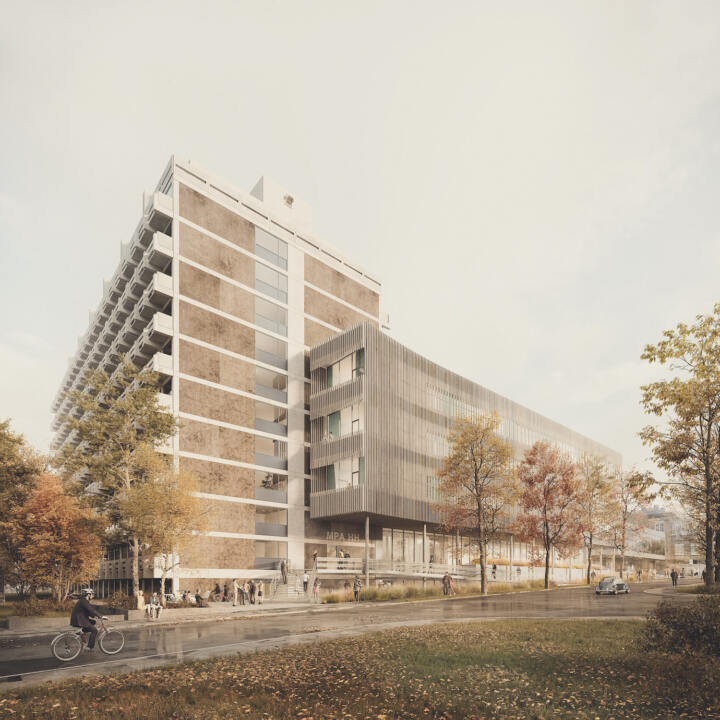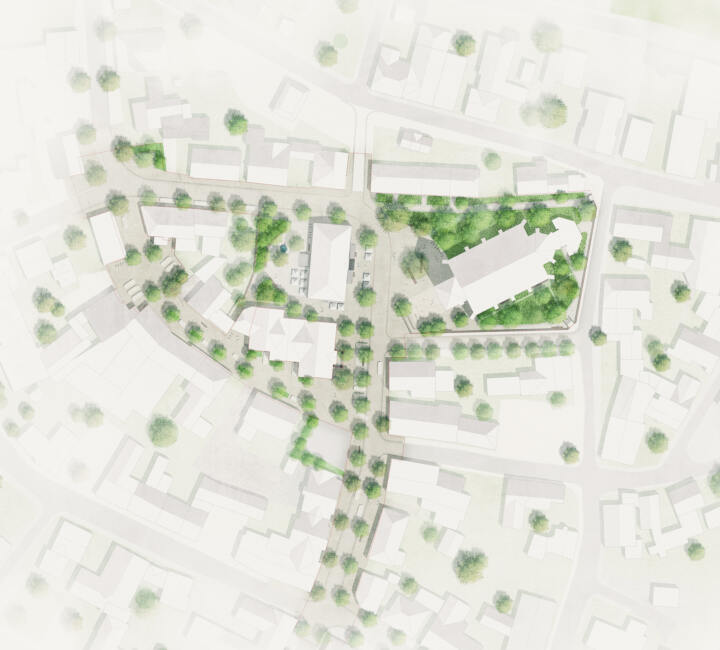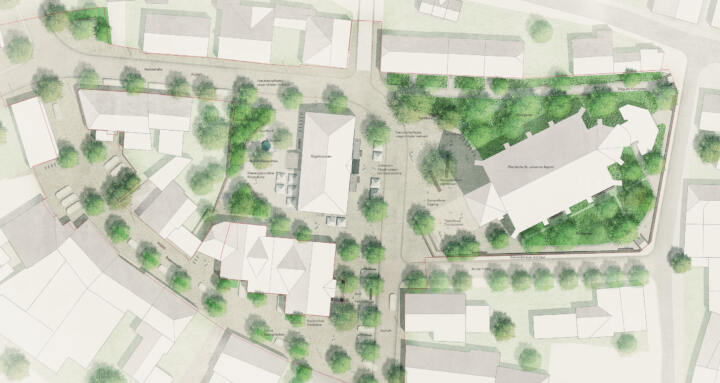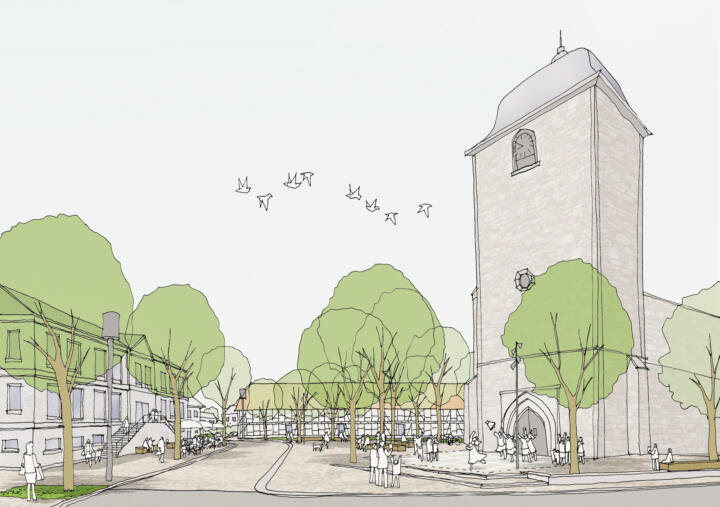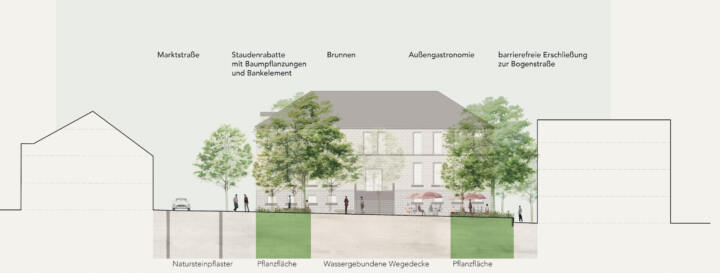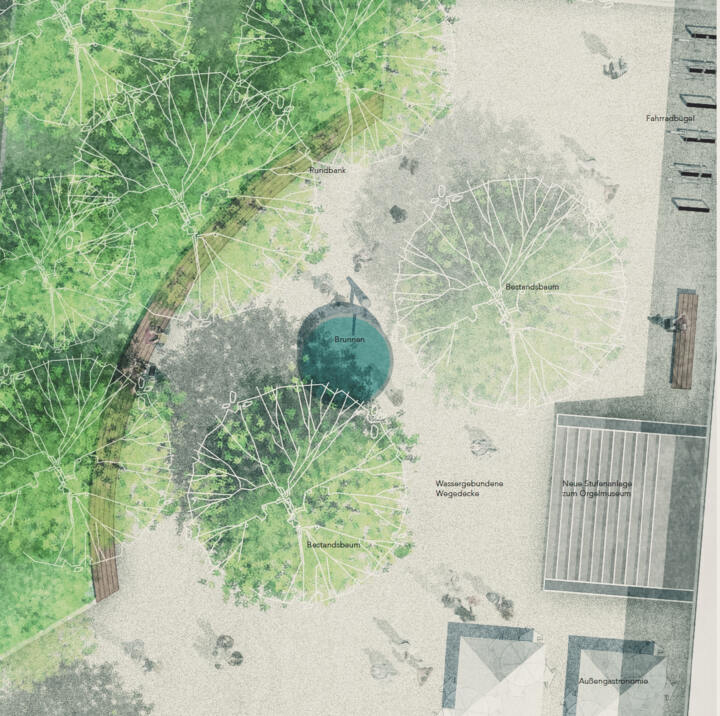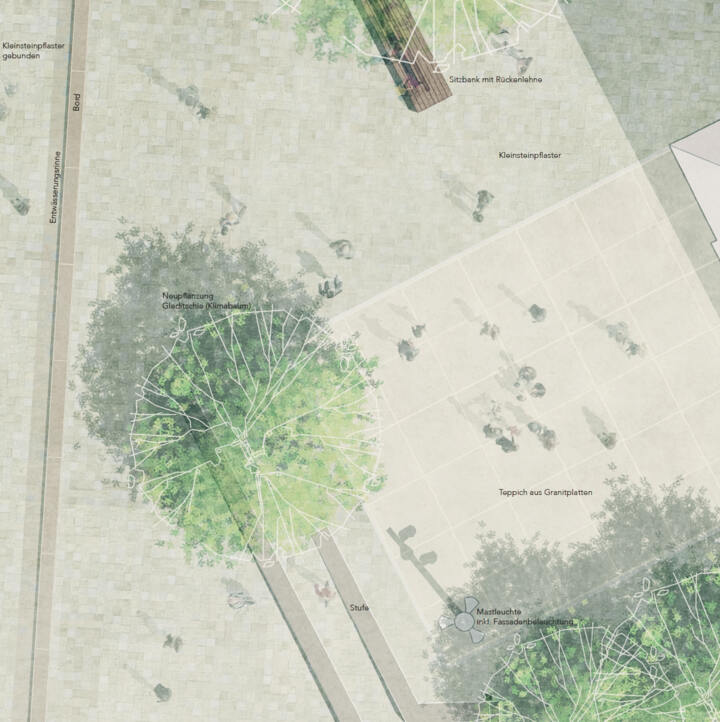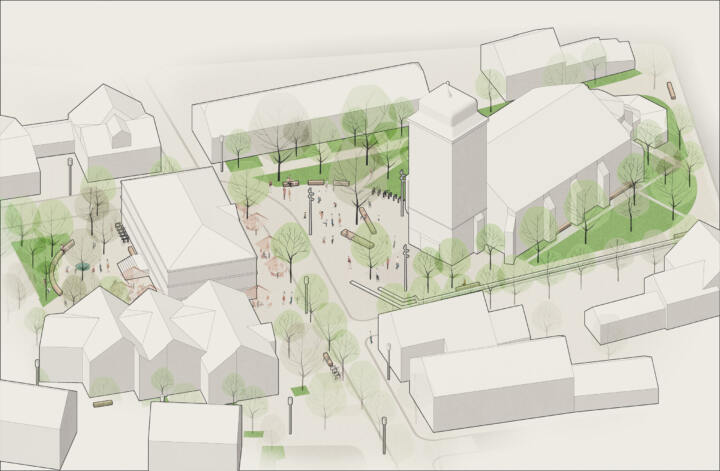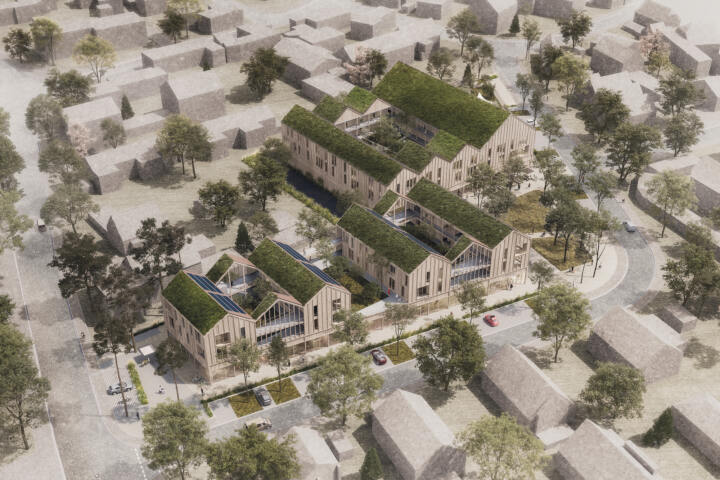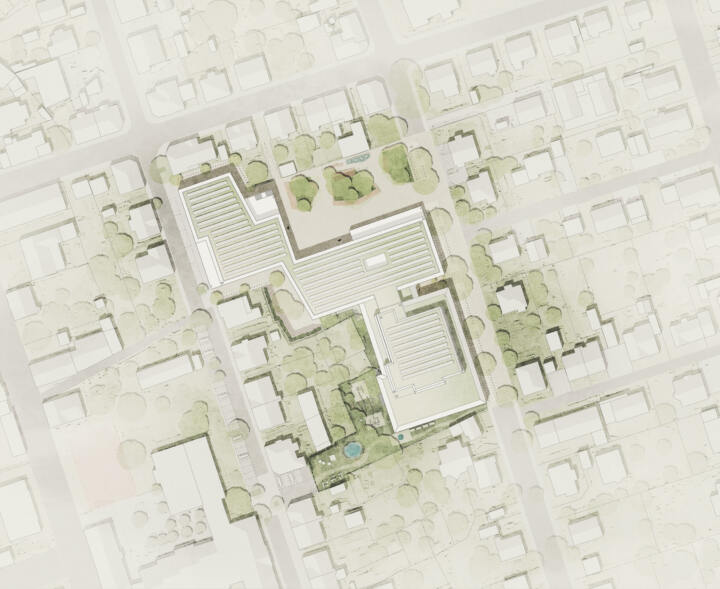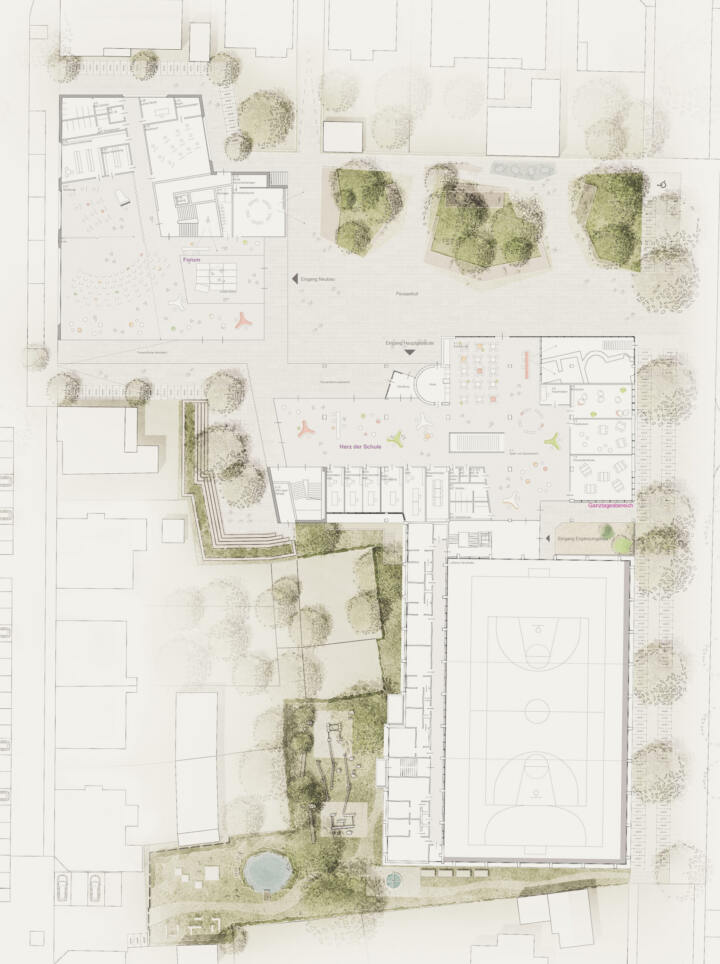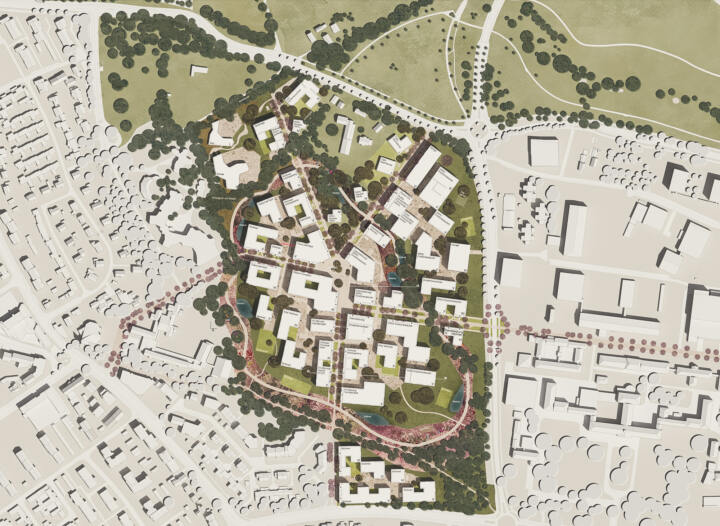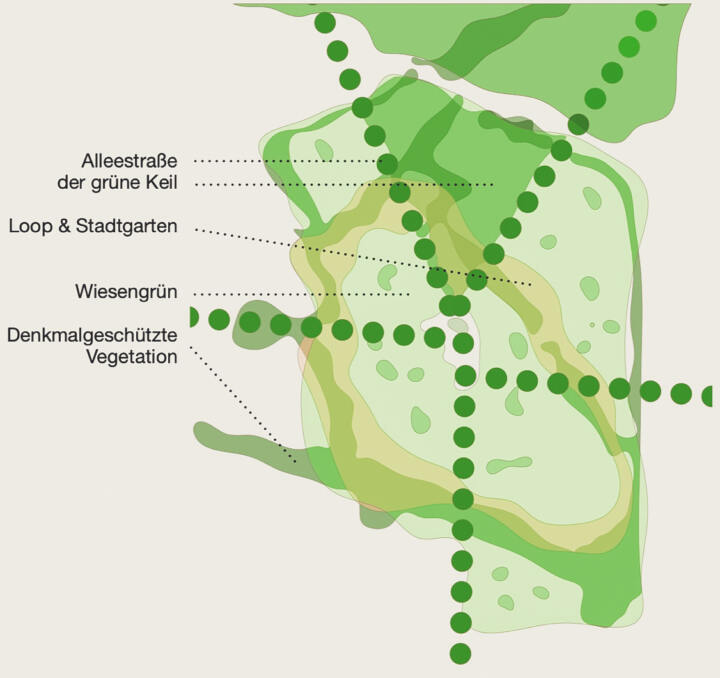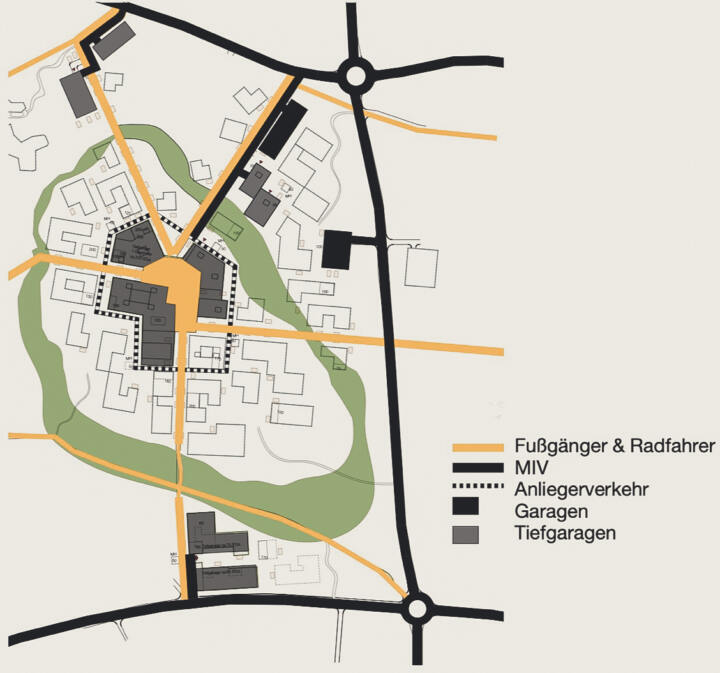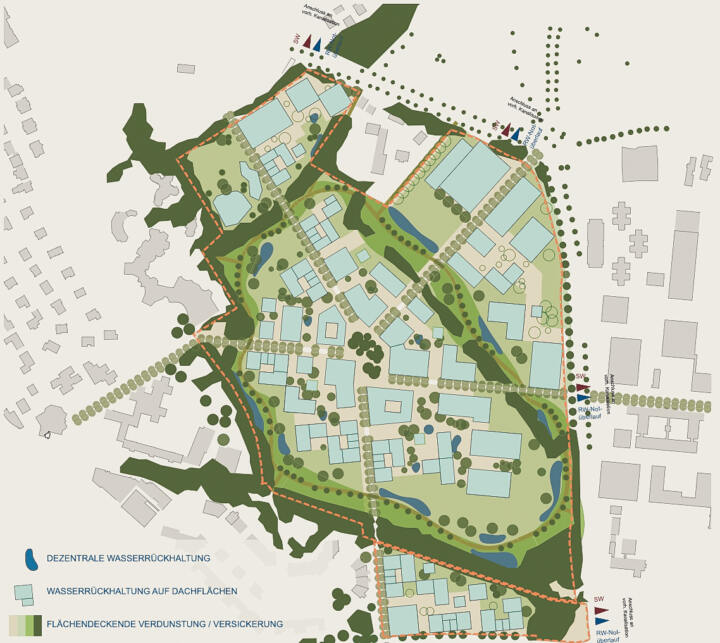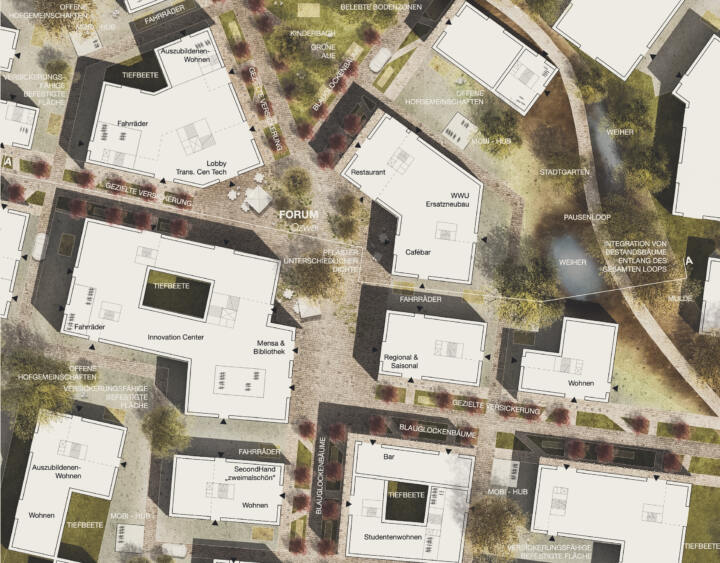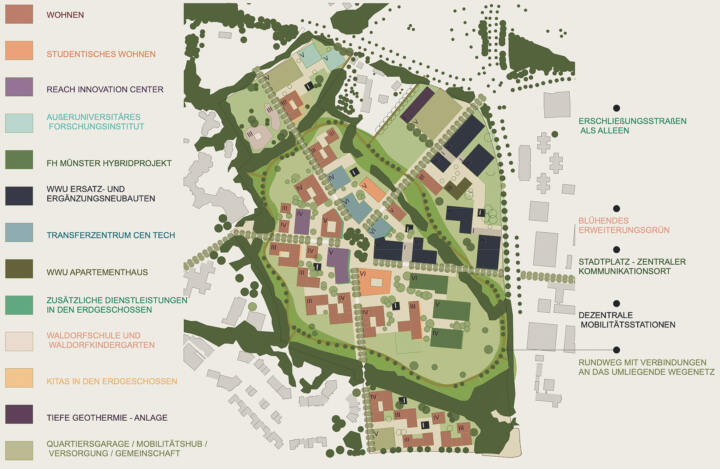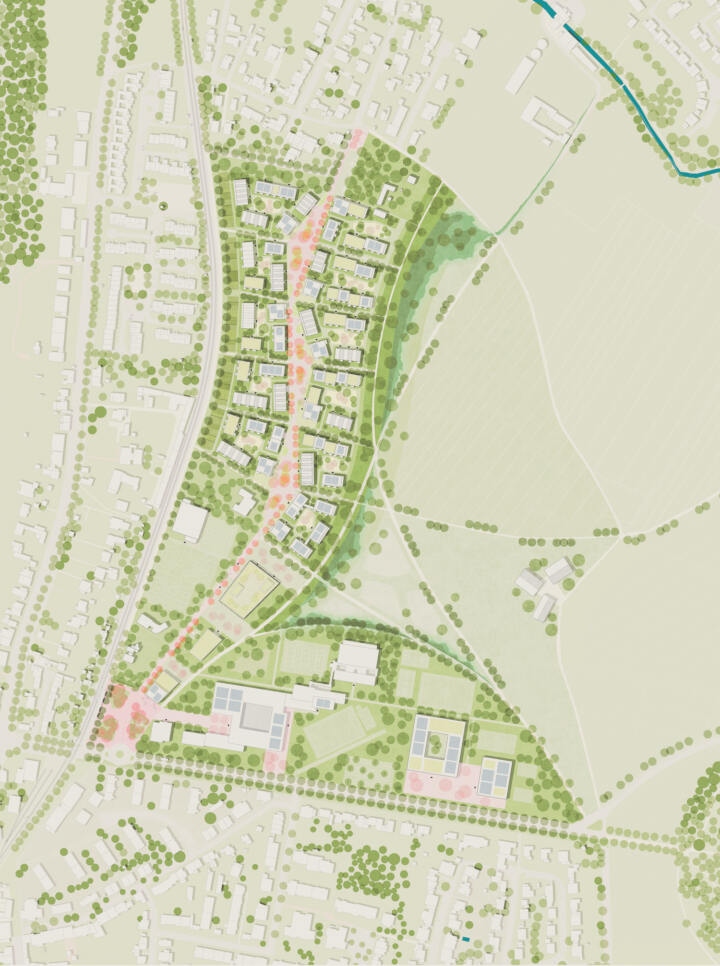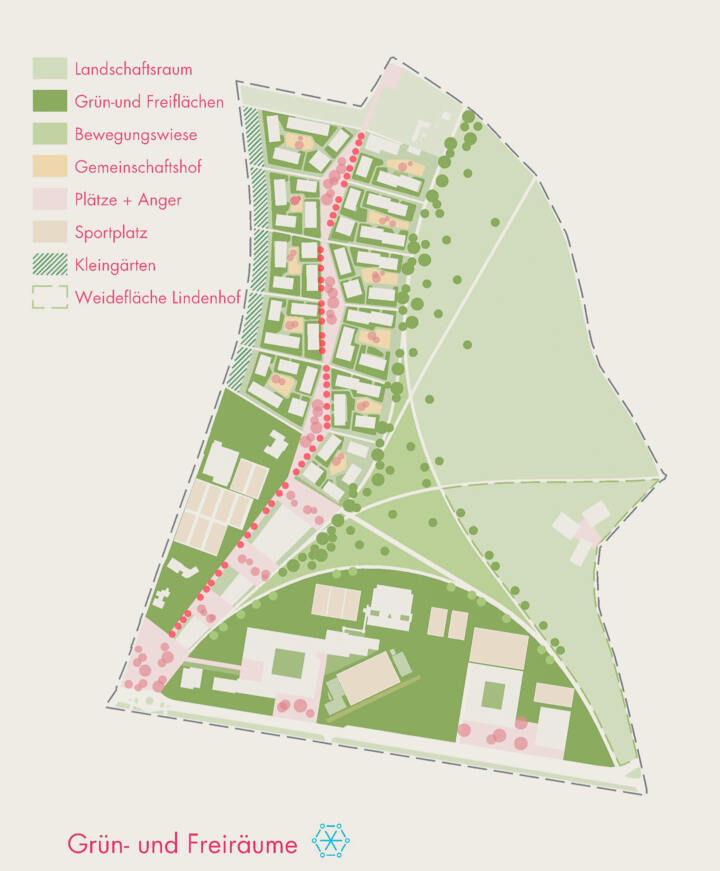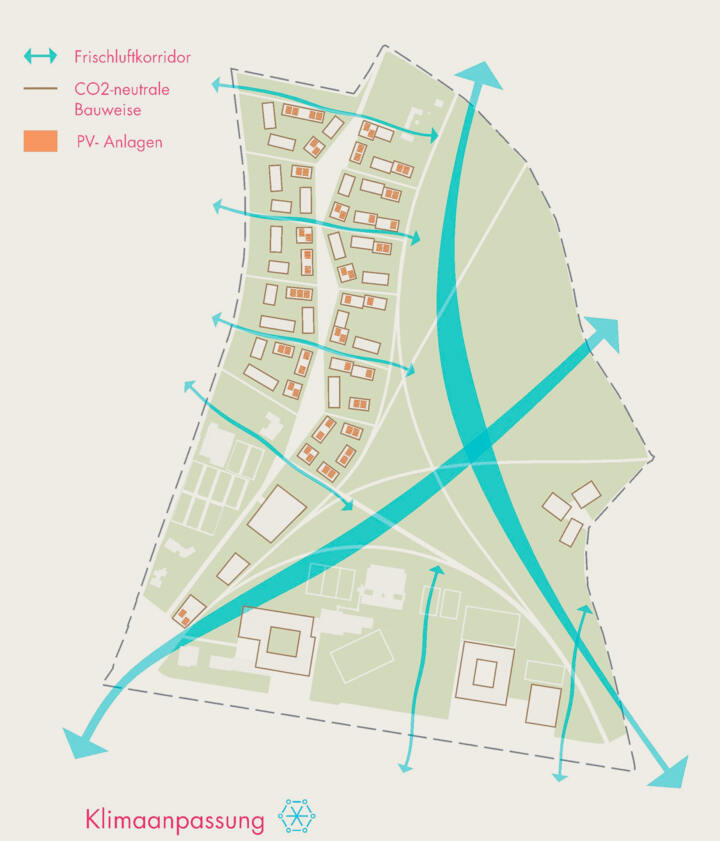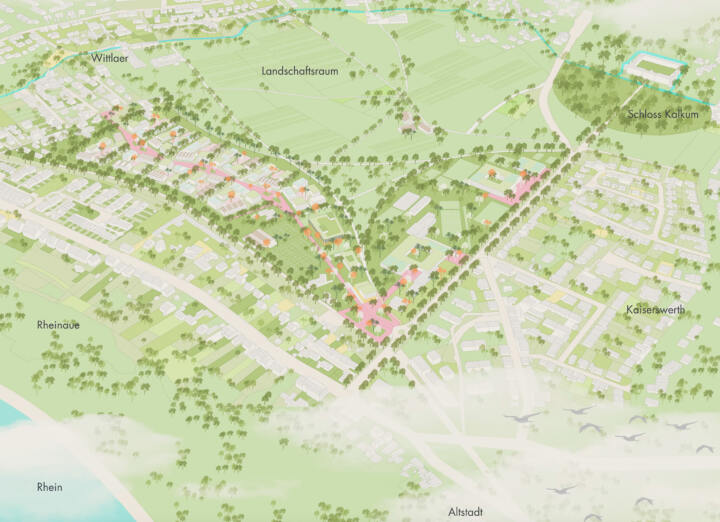Max-Planck-Institute | Mülheim an der Ruhr
2nd prize | Max Planck Institute
Mülheim an der Ruhr
Urban integration ❘ The campus of the Max Planck Institutes in Mülheim an der Ruhr is completed by the new building for the analytical departments. The building fits in between the lecture theatre building and the laboratory tower without being subordinate. The desired representative, semi-public connection from the main entrance in the lecture theatre building to the high-rise laboratory building is created via a connecting corridor oriented towards Lembkestraße and visible from the street. The design of the new building utilises the opportunity to combine living and meeting spaces that are visible from the outside with modern working environments. The central element of the “living room” on each level at the transition to the high-rise building with a view towards the city centre illustrates this and provides insights into the world of the researchers from the street space. Just as the oldest and representative building of the former Kaiser Wilhelm Institute on the square of the same name forms a striking prelude to the campus to the south, the new building now does the same in addition to the high-rise laboratory building on the north side facing the city.
Open space quality ❘ The centrepiece of the campus will be the new, green living room in the courtyard, which extends the range of communicative break and retreat areas beyond the actual courtyard area. The courtyard itself fulfils all requirements for deliveries and escape routes and provides enough space for small and large parties. Sealing is kept to a minimum. The levelling of the green areas is achieved by terracing the lawns with seating steps that invite people to linger. The gradients on the lower courtyard level lead the surface water visibly and tangibly towards the green areas. The striking materiality of the surfaces in the area of the new CEC buildings in the form of polygonal slabs is continued in the courtyard in order to standardise the design. The existing attractive grass planting will also be continued wherever active open space utilisation is not possible, such as on Lembkestraße or along the new CEC building in the north of the courtyard.
Architectural quality ❘ The new building responds to the respective floor plan organisation and storey height at the transitions to the lecture hall building on one side and the laboratory tower on the other. The façade materials echo the colours of the existing buildings on the one hand, while sustainable materials are used on the other. A new type of vertical greening system is integrated into the façade on the courtyard side. The system is managed seasonally: the automatically irrigated modules are planted with seeds in spring, the plants grow in summer and are “harvested” in autumn, including the compostable trellis. This eliminates the need for pruning and leaf disposal and the positive energy input from sun and light in winter is not affected.
Sustainability and materiality ❘ In line with the guiding principle of sustainable and future-proof construction, the construction system is characterised by a low-restriction, prefabricated and minimised basic structure. The prefabricated composite slabs and partially prestressed hollow-core slabs with high rigidity ensure low susceptibility to vibrations. Low-CO2 concrete with a proportion of recycled aggregate is used to increase cost-effectiveness and sustainability. The foundation is laid on an elastically bedded floor slab. The outer shell consists of a non-load-bearing, highly efficient and energy-generating façade made of wood, glass and PV modules.
City Centre | Borgentreich
3. Prize | City Centre
Borgentreich
A new centre for the organ city
The design concept for the town centre area of the organ town of Borgentreich envisages an upgrading of the historically significant ensemble of church, organ museum and the surrounding half-timbered houses. A strong, green framework will create a central square where the church and the organ museum are located, thus creating a new centre that is appropriate to the location. This square offers space for intergenerational stays, festivals, markets and meetings in front of the church. Appropriate shading and evaporation areas and the use of light-coloured materials will create a climate-adapted urban space.
In the existing building, the organ museum and the church are located on different sides of the street without any connection to each other. There is also a lack of spatial edges around the buildings that would define a common space. By creating a green framework, the necessary boundaries are created. The intensive green framework also forms a sustainable green space within the city. Additional trees will be planted to provide shade and retain moisture in order to minimise the heating of the open spaces in summer. The existing lawns around the church will be transformed into a church garden with herbaceous areas and shrubs. This will allow much more rainwater to seep away and evaporate. When selecting plants, a variety of species is taken into account so that plants are always in bloom throughout the year and thus provide food for insects. At the same time, the plants are robust against longer periods of drought in the summer months. The existing trees will be integrated into the new structure. Individual benches along the church invite visitors to linger in the new church garden.
The open and free square created within the lush, green framework forms the new ‘heart’ of Borgentreich’s town centre. The square is divided into three areas – a church forecourt, a small central town square that extends in front of the organ museum and a further, more secluded square behind the museum. The direct entrance area of the church will have a carpet of large-format, used natural stone slabs. Here, people can stand in the trellis for weddings and socialise after church services. At the end of the carpet, the existing wall to the south merges into two steps that lead down to the street. This further defines and accentuates the church forecourt. Thanks to the natural topography of the square, the church can be accessed barrier-free via the square without any structural installations.
The new small stone paving made of natural stone connects the square areas across the street and draws them together into a single unit. Motorised traffic is guided across the square and sensitised to the use of the square by the visual and tactile change in material.
By slightly reducing the width of the carriageway in favour of the open space, a large, appropriate area is created in front of the organ museum. The space can be used as a place to stay and for catering. Large benches, some with backrests, will be placed around the existing tree in the centre of the square to create a spacious recreation area. The tree is integrated into the paved square with an open tree disc. A space for markets and festivals will be created around the central element to enliven the city centre square. The square will be furnished discreetly and appropriately for the location.
The furniture is made from certified wood and regionally produced materials to avoid long delivery routes. Passing the organ museum on the side, you reach the third area. The green frame also surrounds this area with a lush green back. The square will have a water-bound path surface with light-coloured litter, setting it apart from the central town square in terms of design and giving it its own identity. The existing trees will also be integrated into the new square in order to create large crowns with appropriate shade. A fountain enlivens the small square and provides a pleasant soundscape. The catering facilities are distributed around three sides of the organ museum and thus enliven the adjacent open spaces.
The street space will be massively upgraded with new tree planting. In both Bogenstraße and Marktstraße, the existing motif of the row of trees will be supplemented and completed by new plantings. This will give the street an important green atmosphere. Climate trees suitable for the new challenges in the urban climate will be planted. All new tree plantings will have a tree trench in which the rainwater from the pavements and the street will be collected and seeped away. At the same time, additional water is available to the tree in the event of prolonged drought. The existing tree plantings will be given an open, planted tree disc. The road cross-section will be reduced slightly to create more space for the peripheral areas. The width required for buses to pass each other will be maintained. This will create more space for pedestrians and stationary traffic and give the trees enough room to grow. The new trees will noticeably improve the urban climate, as the shade they cast will reduce the heating of the paved areas and any water that accumulates will be retained in the green areas, where it can seep away and evaporate. The market street will be marked by a low kerb and an open drainage trough.
The redesign gives Bogenstrasse an open, green character. The rainwater that accumulates here runs into the green tree discs of the single-row tree planting, where it can seep away and evaporate. The carriageway itself is only discreetly defined by marker nails. The pavement extends across the entire open space and creates a generous road space in which all road users are equally entitled to use.
Parking spaces for bicycles and cars are created between the tree plantings. Additional seating elements invite people to linger and enliven the street space. The lighting supports the design concept with different intensities. The street lighting will be continued as in the existing design. The new central town square between the church and the museum will also be given special lighting, which will make the new square a single entity even in the twilight and evening hours. The church garden and Rudolf-Reuter-Platz will be fitted with more discreet bollard luminaires.
The design concept, proportions and furnishings are intended to emphasise the character of the small town square. Robust, green and multifunctional, it will be available to residents as a new centre in the future.
Local Supply | Göttingen
2. Prize | Local Supply
Göttingen
In collaboration with pape+pape architekten
The open space concept of the new local shopping centre is defined by generous open and green spaces, which lead to a transformation of the place in which the car is no longer in the foreground.
The spatially sophisticated building design integrates further green spaces into the building itself. The inner courtyards on the first floor take numerous other opportunities out of the buildings to make the centre even greener.
The forecourt opens up the local shopping centre to the neighbourhood and develops into a public square for everyone. The significant reduction in paved areas allows water to seep away more easily and fits in with the sponge city concept.
The preservation of the existing trees and the planting of additional deciduous trees and fruit trees are particularly important for this, but the use of grass paving for the car parks also contributes to this. The remaining paved areas will be fitted with light-coloured concrete block paving.
Numerous seating and recreational areas will also be integrated, which can be found at the café in the north or at the neighbourhood square.
The roof garden and inner courtyards also create a special place to relax and meet with seating and vegetation.
In addition to car parking spaces, particular emphasis is placed on a large number of bicycle parking spaces. Bicycles can be parked at various locations; cargo bikes and e-bikes of all kinds can also be charged and parked, making the local shopping centre modern and inviting. This is supported by parking spaces for car sharing, micro and light vehicles and areas for mixed use.
The daycare centre’s raised garden, which is located on the first floor and protected by wide shrubbery, is particularly noteworthy. In addition to play hills and play elements, there are also other deciduous and fruit trees here, which, in combination with beds in the raised garden and inner courtyard, invite children to plant and eat their own food.
Eugen-Bolz-Secondary School | Rottenburg
Recognition | Eugen-Bolz-Secondary School
Rottenburg
In collaboration with Atelier 30
The existing school area is implemented in a structurally heterogeneous environment.
The new heart of the school landscape is located in the forum of the new building. The central space, which includes a gallery, offers many possibilities for use by the school community.
The future traffic development consists of a successful mix of motorised private and public transport, as well as cycling and pedestrian traffic. With the exception of a few barrier-free parking spaces, cars are parked outside the school area and the existing school grounds are implemented in a structurally heterogeneous environment.
The urban positioning of the buildings on Eberhardstrasse is orientated towards the important footpath connection in the direction of the public transport stops, and opens up the schoolyard in a meaningful way, which, as in the existing building, connects to the footpath in the direction of Sophienstrasse in the north (barrier-free access via a ramp) and opens up towards Mechthildstrasse.
The sections of the open spaces correspond closely to the new school building. The forecourt, which opens onto the street, leads directly into the “heart” of the school campus, the central courtyard between the old and new buildings. The fact that a large part of the courtyard is underpinned by a bunker requires raised planting beds for the necessary tree planting. Chill and learning decks alternating with seating steps turn the resulting raised beds into meeting places during breaks and free periods. The cubature of the raised beds is orientated towards the building structures and creates flowing, semi-open spaces that allow individual occupation of the courtyard while maintaining the necessary clarity. A partially covered area for learning and working at group tables and benches is provided in the northern part of the courtyard, somewhat separated from the break area.
The large playground offers sufficient space for exercise, especially for the younger age groups. The existing exercise facilities to the west of the gymnasium will be supplemented by additional facilities such as calisthenics equipment and parcours elements.
In addition to the requirements of the exercise and learning landscape, the open spaces also fulfil fundamental functions of resilient and sustainable area development. These include a maximum of structurally rich vegetation areas, water-permeable surface paving and rainwater management as a circulation system. All roof surfaces of the school buildings are intensively greened – an approx. 20-30 cm thick layer of substrate stores the rainwater and makes it available to the plants. Where possible, rainwater from the paved areas is channelled into the drainage and storage layer of the raised tree beds and also collected in cisterns for the use of service water.
Busso-Peus Street | Münster
Recognition | Busso-Peus Street
Münster
Concept ❘ A centre, a network full of character, a ring path and the existing, extended vegetation form the basis of the concept for Münster Model Quarter 2. This “nature hybrid” is intended to be an international demonstration project for how sustainable housing and university construction can be combined with intensive reforestation, increased biodiversity and circular resource thinking in a suburban and peri-urban area. Dense and socially networked neighbourhoods are created. What is important is an urban structure in the centre that provokes education, exchange and community and expands along the “avenues”.
The urban-natural landscape ❘ The city and the university merge into a dense sub-centre. The existing vegetation becomes the starting point for a park – for an urban-natural landscape. The urban development project is intended to become a laboratory for the development of a close symbiosis of living and working environments in areas close to the city and help the city of Münster to realise its ambitious nature and climate protection goals. The overlapping of uses will enable a new urbanity on the outskirts of the city. A centre and structural density, consistent networking with the surroundings, the strong framework of tree structures and a mule track through the intensive natural garden are the basis of our concept for Model Quarter 2 in Münster.
Open space concept ❘ A central square forms the heart of the new neighbourhood – a forum. This is where the opportunities for exchange, learning and research are concentrated. Open courtyard communities that form around the central square merge into the landscape. Their informal design allows for diverse appropriation and is characterised by the “open” green surfaces.
The neighbourhood is also surrounded by an open landscape area with meadows for play and sport and additional space for animal enclosures and the learning garden.
A flowering perennial field with a walking path and jogging track surrounds the Allende. This serves as a break and after-work diversion and connects the individual courtyard communities.
Existing rows of trees of the natural monuments remain untouched, are supplemented and form a spatial setting. The Appelbreistiege will be crossed carefully and with narrow bridges over the existing ditches. This crossing is kept to a minimum and is designated exclusively for pedestrians and cyclists.
The green corridor along the Kinderbach stream in the north of the site will be brought right up to the central square of the new neighbourhood. This will provide the existing courtyard complex and even smaller individual buildings in the neighbourhood with a lush green environment.
Path and traffic concept ❘ Star-shaped avenues open up the site. They connect to the existing network of paths and meet in the centre of the site. They connect the new district with neighbouring areas such as the research campus, Münster’s city centre and the centre of Gievenbeck. The most important connection is the route from the city centre via the research campus to the centre of the new quarter. The junction with Busso-Peus-Straße is emphasised by a circle of trees and the new buildings on the west side form a gateway to the new quarter. Of the total of five access roads, four are intended exclusively for pedestrians and cyclists. Each street is lined with green spaces and framed by the buildings.
Coming from the north, from Gievenbecker Weg, motorised traffic will be routed to the central square under the underground car park. Delivery, emergency and refuse vehicles can drive through the neighbourhood on a ring road. The courtyard communities can be delivered via the gravelled lawn areas.
Drainage concept ❘ The design follows the principle of the “sponge city” with the components of evaporation, storage and infiltration of rainwater. If the surface materials allow a low level of evaporation or infiltration, the rainwater that accumulates on the open spaces is channelled to troughs and deep beds via suitably designed open ditches or via cross-slopes created on the paths and squares. These are designed for a high evaporation capacity through appropriate planting, in some cases with trees, and are designed in such a way that they also improve the quality of stay and the microclimate.
In addition, retention areas are used for the temporary storage of rainwater for delayed reuse. Part of this is utilised for water storage and groundwater recharge via infiltration trench systems, tree-riogole systems and additional underground systems.
Kalkumer Schlossallee | Düsseldorf
3. Prize | Kalkumer Schlossallee
Düsseldorf
Landscape shapes the city
In collaboration with schneider+schumacher
The “Landschaft formt Stadt” concept envisages a nature-based and sustainable neighbourhood that takes into account the outstanding quality of the settlement area to be developed with its exposed location to the open landscape, its proximity to the Rhine and the historic old town of Kaiserswerth.
Urban and open space planning concept
The identity is characterised by the direct integration of the landscape and the mix of housing types. The green and open space extends from the Kalkumer Schloßallee railway station to the landscape (in the direction of Bach-Aue) and divides the urban figure into a multi-generational campus in the west and an educational campus in the south of the planning area. This creates a clearly defined edge to the town, formulating a visual reference to the open landscape. The shaping of the landscape space between the residential areas creates strong ventilation and greenery. Residents will be able to experience the space as a local recreation area. The overarching network of footpaths and cycle paths connects the open landscape with the surrounding neighbourhoods. The urban planning organisation defines interconnected building plots in the sense of an “urban village”, which provides for a diverse and flexible building structure for different forms of housing and architecture, and for several generations.
Transport/mobility concept
The area is characterised by excellent public transport connections. This is ensured by the railway station “Kalkumer Schlossallee” in the south-west and “Am Mühlenacker” in the north-west as well as a bus stop on Kalkumer Schlossallee. The concept envisages that only an efficient road connection between the neighbourhood in the south and Kalkumer Schlossallee is to be realised.
Open spaces
All squares and streets follow the principle of the sponge city with the highest possible proportion of unsealed surfaces. Where sealed areas are required, care is taken to use permeable surfaces wherever possible. In addition, the green areas are slightly recessed in order to retain rainwater and allow it to seep away and evaporate directly on site. This mix of green and paved areas also offers a wide variety of recreational and play areas. The entrance to the new neighbourhood is formed by a large square that connects the railway station, the school and the new residential area. Various meeting and recreational areas for young and old will be created here, structured by large green spaces. In the residential neighbourhood, the village green will create attractive public squares and play areas without traffic congestion. Semi-public residential courtyards and the private and communal green spaces assigned to the ground-floor flats will be created, resulting in communicative neighbourhoods. The northern end will have a small square with a play area as an entrance from the existing residential development. In addition to the obligatory climate resilience of the large trees, the choice of plants is orientated towards a flower-rich, near-natural appearance with high drought tolerance, which not only strengthens biodiversity but also offers varied flowering aspects throughout the year.Small climatic forests will be planted on the edges of the railway and school campus to act as a buffer to the buildings.All footpaths in the landscape area are loosely accompanied by fruit trees and link up with the surrounding network of paths – the landscape area thus retains its expanse.It is proposed to relocate the existing Lindenhof riding centre to the landscape area, as this will allow for future expansion and development.The sports and leisure areas, including the three extended tennis courts, are arranged in such a way as to create synergies with the utilisation of the open spaces.



